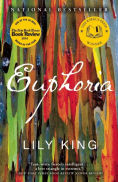King’s exciting novel, which has gotten mostly rave reviews, tells the story of three anthropologists doing field work in New Guinea: Nell Stone, her husband Fen, and Andrew Bankson. The three meet up when Nell and Fen are fleeing from the suddenly threatening tribe they have been living among and studying. The couple are in bad shape: both are unwashed and ill with malaria; Nell has lost her glasses and broken her ankle. They are a godsend, though, to Bankson, so desperately lonely that he’s recently attempted suicide.
Nell’s latest book has become a surprise best-seller, leaving Fen fiercely jealous of her fame. Fen, who seems to prefer hanging out with the men and living a native life rather than actually completing the field work he’s taken on, soon has more to be jealous of when Bankson falls for Nell in a big way. First, though, Bankson falls for them as a couple and persuades them to study a tribe not far from the one he lives among, so that he can see them occasionally.
The novel, this month’s read for my book club, is “inspired by” the true story of Margaret Mead, her husband Reo Fortune, and the English anthropologist Gregory Bateson. The three worked together on a 1933 field trip to New Guinea.
King has done her research. I especially appreciated the portrait of Mead. This is a heroine who is not gorgeous. In fact, she’s described as “a sickly, pocket-sized creature with a face like a female Darwin.” What’s beautiful about her is her brain. The passages describing her novel ways of interacting with the women and children of the tribe and those describing her talking about and writing up her findings are mesmerizing.
It’s rare enough that we get a portrait of the role of a career in a woman’s life. For me, the most thrilling scene in the book is not one of the many involving physical or emotional danger, but the scene where the three of them come up with a new way to look at cultures; the mounting excitement as they build on each other’s ideas left me breathless.
Much of the novel is accurate, but some—disturbingly—is wildly fictional. And this brings me to my major concern with the book. Since it is widely acknowledged and even included in the book’s front and back matter that the book is based on the lives of three real people, it seems to me unconscionable to take such liberties with their lives.
For one thing, Fen is presented as almost completely negative. He’s a cad, a bounder, a good-for-nothing. Granted Bankson as the narrator has little reason to see good in Fen as he becomes more and more attached to the man’s wife. Yet, the occasional excerpts from Nell’s diary don’t redress this imbalance. Perhaps Reo Fortune was indeed all of these things, including the darker hints at violence. I don’t know. But trampling a man’s reputation when he’s not alive to defend himself is a low blow.
Some other events are shockingly different from the lives of Mead, Fortune, and Bateson—and not always to their credit. To me, muddying the record of real people’s lives oversteps a moral boundary. If the author is going to take the shortcut of using real people as characters, then she is responsible for sticking as close to the truth of their lives as she possibly can. Here, the story is so engrossing that readers, even those familiar with the details of Mead’s life, will come away imprinted with King’s strong scenes.
In Immortality Milan Kundera describes how people want the “immortality of those who after their death remain in the memory of posterity,” but after we’re gone we cannot control what that memory looks like. He gives many examples, particularly the way Bettina von Arnim controlled the image of Goethe after his death, inflating her flirtation with him into a grand and tragic romance.
My other concern has to do with the ending. King’s book is so well-written, almost too vividly bringing alive the jungle environment and the tribes who live there, building suspense that keeps the reader spellbound. And then boom! It’s over. All the story lines tied up a neat deus-ex-machina (and fictional) bow.
The members of my book club unanimously agreed that, aside from the abrupt ending, it was an absorbing read. We enjoyed learning more about the three anthropologists’ different approaches to their field. Some found their methods unscientific and flawed, without for example accounting for observer bias and the adulterating effect of their presence. Some objected to the portrayal of the native tribes: seen through Bankson’s eyes, they are like children compared to the mature western cultures. However, this is an accurate picture of the standard practices and theories of the time.
For writers of historical fiction, this is a constant problem: how do you accurately depict a past era’s culture while not repulsing the modern reader? It calls for a careful balancing act. I think King succeeds here by giving us a bit of the modern viewpoint in different characters. For example, Bankson begins to wonder if his living among a tribe has changed their habits and culture; Nell treats the women she is studying with respect and as equals, not as children or her inferiors.
While the story is basically a love triangle, the excellent writing and the stunning descriptions of the work lift it into something fresh and exciting. Just check out the facts about the three very real people whose lives have here been carved to fit the author’s glass slipper.
What do you think about using real people as the basis for fiction?

